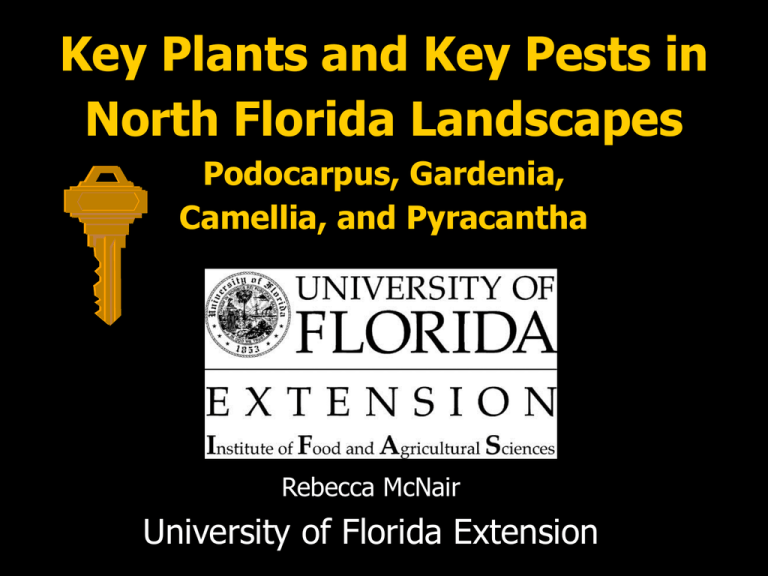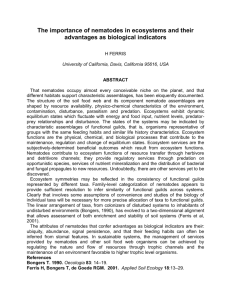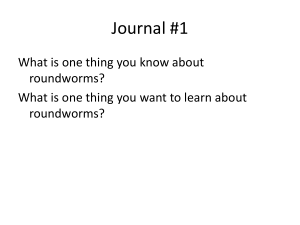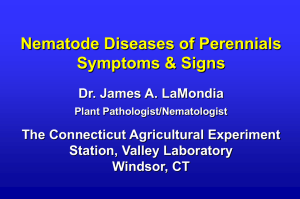Key Plant Key Pest of North Florida
advertisement

Key Plants and Key Pests in North Florida Landscapes Podocarpus, Gardenia, Camellia, and Pyracantha Rebecca McNair University of Florida Extension IPM Integrated Pest Management •Natural processes of control are emphasized –Host plant resistance –Pest exclusion –Prevention and through cultural practices –Physical Control –Biological control through natural enemies –Chemical control as a last resort •Tolerance •Monitoring Podocarpus Nageia nagi Podocarpus- Key Pests Diseases • Mushroom root rot Other • Nematodes • Magnesium deficiency Mushroom Root Rot •Slow decline, thinning of canopy •Gray-green color •White mycelia under bark at soil line Armillaria tabescens Root Rot Management •Remove diseased plants and roots •Fumigate soil before replanting Armillaria tabescens fruiting body appears in fall. Root nodules • Beneficial nitrogen-fixing blue green algae • Often mistaken for root knot nematodes • Active nodules have a pink milky fluid in their centers Hemoglobin within the nodule fixes atmospheric nitrogen. When exposed to oxygen, the fluid inside changes from blue to pink! Root Knot Nematodes •Endoparasitic nematode •Feeds on root tissues •Dieback, decline, chlorosis •Identify under microscope Roots infected with Meloidogyne are swollen. Nematode Management egg mass •Fumigate Meloidogyne sp. •Solarize soil •Buy plants grafted with resistant varieties •Provide adequate water and fertilizer •Remove and replace plants and soil Magnesium Deficiency • Yellow inverted “V” • Occurs on mature leaves • Low soil pH • Lack of soil Mg Management • Increase pH with dolomite • Apply Epsom salts or Mg fertilizers Gardenia augusta • Acid loving plant • Fragrant flowers Gardenia- Key Pests Diseases •Stem Canker Other •Nematodes •Manganese deficiency •Environmental stress Stem Canker • Sudden wilting • Chlorosis • Leaf spots • Yellow halo around lesions • Stem cankers • Galls, usually at the soil line • Girdling may occur Stem Canker • Fungus pathogen enters injured tissue • Spores spread by splashing water Management • Minimize plant injury • Avoid overhead irrigation Phomopsis gardeniae Notice the yellow halo around the leaf spots on this gardenia. Nematodes •Roundworms •Root Knot nematodes live inside plant roots •All live in liquids, i.e. water in soil •Feed on plant sap •Damage roots •Inhibit growth Root-Knot Nematodes • Decline and thinning of canopy • Roots brown, stunted and galled Decline due to root knot nematodes compared to a healthy gardenia. Nematode Management •Fumigate Meloidogyne sp •Solarize soil •Buy plants grafted with resistant varieties •Provide adequate water and fertilizer •Remove and replace plants and soil Manganese Deficiency • Interveinal chlorosis on new growth • Reduced leaf size • Necrotic distortion of new growth • Common in alkaline soils high in phosphorous Management Use a complete fertilizer with micronutrients Environmental Stress • Excessive water or fertilizer • Cold or temperature fluctuation • Nutrient Deficiency • Drought • High pH • Mechanical damage Management •Correct cultural problems •Provide cold protection •Prune and re-grow Chlorosis Bud drop Camellia japonica •Acid loving •Prefers partial shade •Fragrant flowers from late winter to early spring Camellia- Key Pests Diseases •Crown Gall •Petal blight •Leaf spot •Twig dieback Other •Environmental stress Gall •Galls can appear on any plant part and may be due to bacteria, fungi, nematodes, or insects. Agrobacterium tumefaciens is a common soil bacterium that causes crown gall disease by transferring some of its DNA to the plant host. This has enabled scientists to genetically manipulate plants, a technique called transformation. Petal Blight • Irregular, brown spots • Dark veins • Blighted flowers drop • Prefer warm, moist conditions • Ascospores are spread by water • Fungus overwinters as sclerotia, a hard black structure that remains viable for 5 years Cibornia camelliae (formerly Sclerotinia) Sclerotia Petal Blight Control • Suppress sclerotia development • Remove all infected flowers, leaves, and litter • Promptly burn or bury diseased materials (at least 1 ft deep) • Limit overhead irrigation Cibornia camelliae fruiting body. Fungal Leaf Spot • Circular or irregular lesions • Margins raised • Brown - gray • Fungus favors high humidity and partial shade Management • Limit overhead irrigation • Avoid crowding • Copper fungicides Cerscospora caloloma Algal Leaf Spot •Wide host range •Smooth leathery leaves are more prone to infection •One of the few green algae parasitic on higher plants Management •Limit overhead irrigation Cephaleuros virescens Twig Dieback •Fungus •Summer-winter: Glomerella cingulara • cankers •Spring: • Young shoots wilt and die • Brown leaves remain on the dead shoots Twig dieback and a healthy camellia. Twig Dieback • Leaf scars are most common point of entry • Often confused with root rots • Plants can be infected by both • Root rot increases the severity of twig dieback Management • Prune infected areas, including cankers • Fungicides Environmental Stress •High heat and light •Temperature fluctuation •Drought •Mechanical damage Bud Drop Management •Maintain adequate water Pyracantha coccinea •Firethorn •Prefers full sun •Will grow in partial to fairly heavy shade •Fast growing Pyracantha- Key Pests Diseases •Fireblight Fireblight • Bacterium • New shoots wilt suddenly and die • Dead leaves remain on the shoots Erwinia amylovora • Spread by bees and splashing water Fireblight • Bacteria enter through flowers and infection spreads into the stem Management • Limit overhead irrigation • Remove infected branches • Use resistant varieties Acknowledgements Authors: Reviewers: Funding: Photos: Rebecca McNair Dr. Russ Mizell, Dr. Norman Leppla, Dr. Doug Caldwell, Celeste White, and Christine KellyBegazo Florida Yards and Neighborhoods Thanks to the Florida Dept. of Agriculture and Consumer Services, Division of Plant Industry, and University of Florida Extension faculty for providing photographs, including: Dr. James Castner Dr. Lance Osborne Dr. Norman Leppla Bill Graves Holly Glenn Dr. Eileen Buss Dr. Dr. Dr. Dr. Dr. Catherine Mannion Avas Hamon George Agrios Doug Caldwell Tim Schubert











